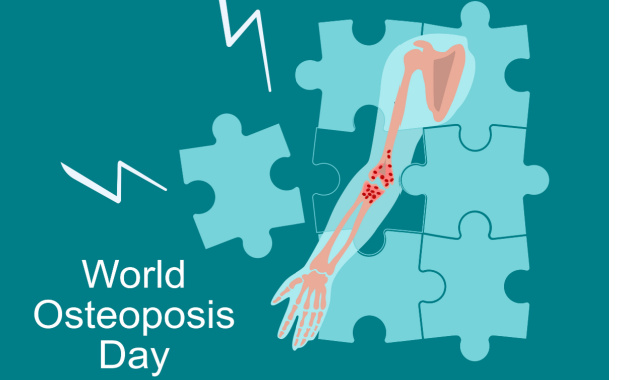
World Osteoporosis Day is observed on October 20 every year to raise awareness about the importance of bone health. The theme for World Osteoporosis Day 2023 is “Build Better Bones,” emphasizing the need for proactive steps toward maintaining strong and healthy bones to prevent the risk of osteoporosis. In this article series, we will explore various strategies and lifestyle choices that can contribute to stronger bones, enabling individuals to lead an active and independent life.
1. Exercise for Stronger Bones: The Importance of Weight-Bearing Activities
Regular exercise, specifically weight-bearing activities, plays a crucial role in maintaining strong and healthy bones. These exercises involve the use of gravity to put stress on the bones, stimulating them to become stronger. Examples of weight-bearing activities include walking, running, dancing, hiking, and weightlifting. By engaging in these exercises regularly, individuals can improve bone density and reduce their risk of developing osteoporosis. It is important to note that if you are prone to any kind of bone disorders; always consult a healthcare professional before doing any exercises [1].
2. Calcium-Rich Foods: Nourish Your Bones with the Right Nutrients
Calcium is a vital nutrient for maintaining strong and healthy bones. Consuming calcium-rich foods can help nourish your bones and prevent the development of osteoporosis. Some excellent sources of calcium include dairy products like milk, cheese, and yogurt. Additionally, leafy green vegetables such as spinach and kale are also rich in this essential mineral. Other options include fortified cereals, tofu, almonds, and sesame seeds. By incorporating these calcium-rich foods into your diet regularly, you can ensure that your bones receive the nutrients they need to stay strong and resilient.
3. Vitamin D and Sun Exposure: Boosting Bone Health Naturally
Vitamin D is crucial for maintaining strong and healthy bones. One of the best ways to get an adequate amount of this essential nutrient is through sun exposure. When our skin is exposed to sunlight, it produces vitamin D, which helps the body absorb calcium and promote bone health. However, it’s important to practice safe sun exposure by avoiding peak hours when the sun’s rays are strongest and wearing sunscreen to protect against harmful UV rays. If you live in an area with limited sunlight or have difficulty getting enough vitamin D from sun exposure alone, consider consulting with your healthcare provider about supplementation options.
4. Say No to Smoking and Limit Alcohol Intake: Protecting Your Skeleton
Smoking and excessive alcohol consumption can significantly impact your bone health. Smoking reduces blood flow to the bones, which hinders their ability to receive essential nutrients for growth and repair. Meanwhile, long-term alcohol consumption may interfere with the body’s absorption of calcium. By saying no to smoking and limiting your intake of alcohol, you are taking important steps toward protecting your bones [2,3].
5. Regular Bone Density Testing: Early Detection for Effective Treatment
Regular bone density testing is crucial for early detection and effective treatment of osteoporosis. This simple test measures the strength and density of your bones, helping to identify any signs of bone loss or weakness. It is recommended that women over the age of 65 and men over the age of 70 undergo regular bone density testing, but individuals with risk factors such as a family history of osteoporosis or certain medical conditions may need earlier screening [4].
6. The Role of Hormones in Bone Health: Understanding the Impact of Estrogen and Testosterone
Estrogen and testosterone play a significant role in bone health, in women and men respectively. Estrogen helps regulate bone density by inhibiting osteoclasts, the cells responsible for breaking down bone tissue. In postmenopausal women, decreased estrogen levels can lead to accelerated bone loss and an increased risk of osteoporosis. Similarly, testosterone plays a vital role in maintaining bone density in men. Understanding the impact of these hormones on our skeletal system can help us take proactive measures to prevent osteoporosis and keep our bones strong and healthy throughout life [5].
7. Nutritional Supplements for Stronger Bones: Enhancing Diet with Vitamins and Minerals
Nutritional supplements can play a crucial role in enhancing bone health and preventing osteoporosis. Calcium and vitamin D are essential for maintaining strong bones, but sometimes it can be challenging to get enough through diet alone. That’s where supplements come in. Calcium and vitamin D supplements can help ensure your body has the necessary nutrients to build and maintain healthy bones. Additionally, other minerals like magnesium, zinc, and copper also contribute to bone strength. Consult with your healthcare provider to determine the right dosage of these supplements based on your age, gender, and overall health.
Let us prioritize our bone health by adopting these practices into our daily lives and spreading awareness about the significance of World Osteoporosis Day.
(The article is written by Monalisa Deka, Senior Health Content Editor)
References
1. American Academy of Orthopaedic Surgeons. Exercise and Bone Health. Available online: https://orthoinfo.aaos.org/en/staying-healthy/exercise-and-bone-health/#:~:text=Weightbearing%20Exercise&text=When%20your%20feet%20and%20legs,Brisk%20walking%20and%20hiking
2. Sampson HW. Alcohol’s Harmful Effects on Bone.Alcohol Health Res World. 1998; 22(3): 190–194. Available online: https://www.ncbi.nlm.nih.gov/pmc/articles/PMC6761900/
3. Yang C, Lai JC, Huang W, et al. Effects of sex, tobacco smoking, and alcohol consumption osteoporosis development: Evidence from Taiwan biobank participants.Tob Induc Dis. 2021; 19: 52. Available online: https://www.ncbi.nlm.nih.gov/pmc/articles/PMC8210532/
4. Vondracek SF, Linnebur SA.Diagnosis and management of osteoporosis in the older senior. Clin Interv Aging. 2009; 4: 121–136. Available online: https://www.ncbi.nlm.nih.gov/pmc/articles/PMC2685234/
5. Khosla S, Oursler MJ, Monroe DG. Estrogen and the Skeleton. Trends Endocrinol Metab. 2012 Nov; 23(11): 576–581. Available online: https://www.ncbi.nlm.nih.gov/pmc/articles/PMC3424385/c